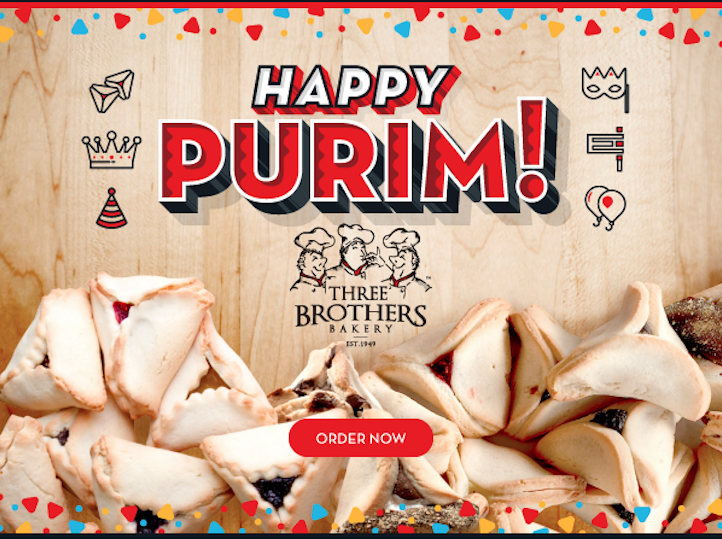How can something so sweet represent something so evil? Not sure what we mean? Beginning on March 20th, all of us at Three Brothers Bakery will celebrate Purim. Some will fast, dress up in costume, or enjoy family dinners; while others will give gifts to the poor, dance to Purim music, and/or drink wine. There are a variety of ways Jews can celebrate this celebratory holiday. But one of the most common and recognizable ways to observe Purim is by eating Hamantaschen. Let us explain why something so sweet really does represent something that is so historically evil.

History of Purim
It begins when King Ahasuerus of the Persian Empire (modern day Iran) in the 4th century BC had his wife, Queen Vashti, executed for failing to follow his orders. He then arranged a beauty pageant to find a new queen. A Jewish girl named Esther won and became the new queen, though she refused to divulge her religion.
In the meantime, the Jewish-hating Haman was appointed prime minister of the empire. The leader of the Jewish people (and Esther’s cousin), Mordechai, refused to bow to Haman. Haman was incensed, and he convinced the king to issue a judgment ordering the extermination of all the Jews on the 13th of Adar, a date chosen by Haman. (FYI: Adar is the name of a month in the Jewish calendar.)
Mordechai convinced the Jewish people throughout the land to repent, fast, and pray to G-d. Meanwhile, Esther revealed her Jewish identity to the king and told him of Haman’s sinister plans. As a result, Haman was hanged and Mordechai was appointed prime minister in his place. A new law was issued, granting the Jewish people the right to defend themselves against their enemies.
On the 13th of Adar, the Jews came together and triumphed over many of their enemies. On the 14th of Adar, they celebrated their victory and new freedom, and today we tell the story of Esther, the Megillah, every year on that day.
Celebrations
Often considered the Jewish equivalent to Halloween, many Jews dress up as either, Esther, Queen Vashti, Haman, Mordecai, and King Ahasuerus. Attending synagogue and hearing the story of Esther is a common practice. The entire congregation writes the name “Haman” on the soles of their shoes. Additionally, they’re encouraged to carry noisemakers known as Gregors to synagogue. As they listen to the Rabbi retell the story every time the name “Haman” is mentioned they stamp their feet and spin their Gregors, drowning out the much hated name of Haman.
Feasts, costume parties, and dancing are popular activities on Purim. But nothing symbolizes the holiday more than Hamantaschen.
So What are Hamantaschen and Why Do We Eat Them on Purim?
One of the largest symbols of Purim is the Hamantaschen cookie. They are triangular shaped treats made of dough containing poppy seeds or fruit jam in the center. The shape represents Haman’s hat that he wore during his reign. Earlier versions of the cookie were known as Oznei Haman, translated to “Haman’s ears.” This is considered a reference to cutting off a criminal’s ear before their execution. Many believe that Haman’s ears had been cut off after he was hung at the end of the Purim story.
Sometime in the 18th or 19th century in Germany and Eastern Europe, a triangular shaped pocket filled with the aforementioned jam or poppyseeds became very popular. It was called Mohntaschen, mohn meaning poppyseed and taschen meaning pocket. Eventually it evolved into Hamantaschen.
**As of May 8, 2019, none of our locations are certified Kosher.**
At Three Brothers Bakery we offer these delectable treats with the traditional fillings of poppyseed, apricot and prune and also with other various jam filings including lemon, blueberry, raspberry and cherry. We also sell non-fruit fillings with delicious chocolate, Nutella, and even a Kosher s’mores version. During Purim we also offer a cheese hamentaschen. The American version of Hamantaschen is more of a cookie dough style, whereas the traditional treat is made using yeast.
Purim and Hamantaschen
Whether you choose a raspberry jam filling and opt to dress up as Queen Vashti, or attend synagogue and enjoy a lavish dinner at home, it is your choice. With so many different ways to celebrate Purim, it truly is a holiday for all Jewish people young and old. As March rapidly 20ht approaches why not order your Hamantaschen through Three Brothers Bakery? It’s an opportunity to savor something sweet that brings remembrance to a time when good overcame evil for the Jewish people And everything good must be celebrated with something good to eat – right? So hamentaschen it is!
PS: Our hamentaschen are so beloved that we make them all year round. So for those who want their favorite all year round – we’ve got you covered.